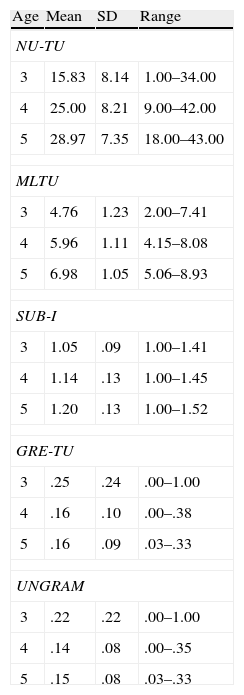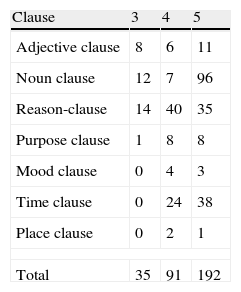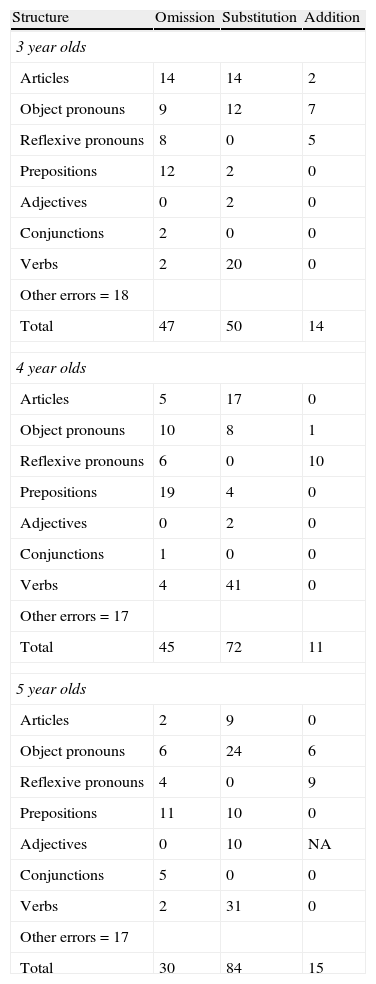This study investigated spontaneous language measures (SLM) derived from a narrative task among Spanish-speaking (SS) preschool children to provide clinicians with developmental data on SLM and to examine whether SLM show changes in development for SS preschool children. A total of 110 monolingual SS children participated in this study. Children were divided into 3 age groups: 3, 4, and 5 years of age. Two general language measures were collected from the children: a standardized receptive vocabulary measure (Test de Vocabulario en Imágenes, TVIP), and a parental report of speech and language problems (PRSLP). In addition, four developmental language measures were calculated from a language sample collected using a story-retelling task: number of T-units (NU-TU), mean length of T-units (MLTU), subordination index (SUB-I), and grammatical errors per T-unit (GRE-TU). No statistically significant differences were found between the age groups on the standard scores for the TVIP or problem scores for the PRSLP, showing that the age groups were comparable. Increasing developmental patterns were found for NU-TU, MLTU and SUB-I. These data represent an important step in the characterization of typical language development for Spanish-speaking children. The use of the means and standard deviations obtained in this study may assist clinicians and researchers in the identification of potential language disorders in SS children.
En este estudio se han examinado algunas medidas del lenguaje espontáneo (SLM, por sus siglas en inglés) a partir de una narración en un grupo de niños hispanohablantes en edad preescolar. El objetivo de este trabajo es ofrecer una descripción del desarrollo de esas SLM y comprobar si muestran cambios significativos a lo largo del desarrollo lingüístico de los niños hispanohablantes. Los participantes en este estudio fueron 110 niños hispanohablantes monolingües divididos en tres grupos de edad: de 3, de 4 y de 5 años. Se tomaron dos medidas generales del lenguaje: el vocabulario receptivo con el TVIP (Test de vocabulario en imágenes) y la existencia de dificultades de habla y lenguaje por medio de un informe de los padres (PRSLP). Además, se utilizaron cuatro medidas de lenguaje espontáneo extraídas de la muestra de lenguaje: Número de unidades T (NU-TU), Longitud media de unidades T (MLTU), Índice de subordinación (SUB-I), y Número de errores gramaticales por unidades T (GRE-TU). No se encontraron diferencias significativas entre los grupos en los resultados del TVIP y del PRSLP, lo que ponía de manifiesto que los grupos eran iguales en habilidades lingüísticas generales. Las medidas NU-TU, MLTU y SUB-I mostraron un perfil evolutivo ascendente, con diferencias estadísticamente significativas entre los grupos. Estos datos son importantes para la caracterización del desarrollo típico del lenguaje en niños hispanohablantes, y pueden ser utilizados por logopedas y fonoaudiólogos para identificar trastornos de lenguaje en población de habla hispana.
Artículo
Comprando el artículo el PDF del mismo podrá ser descargado
Precio 19,34 €
Comprar ahora













